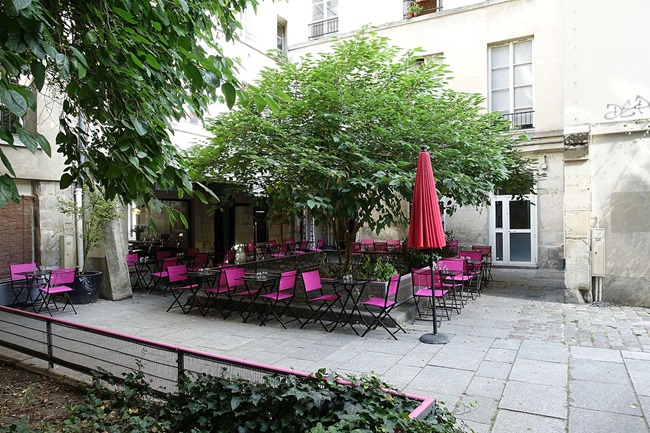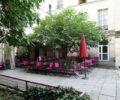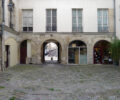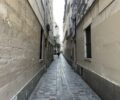Timeless Marais: Explore the Village Saint-Paul
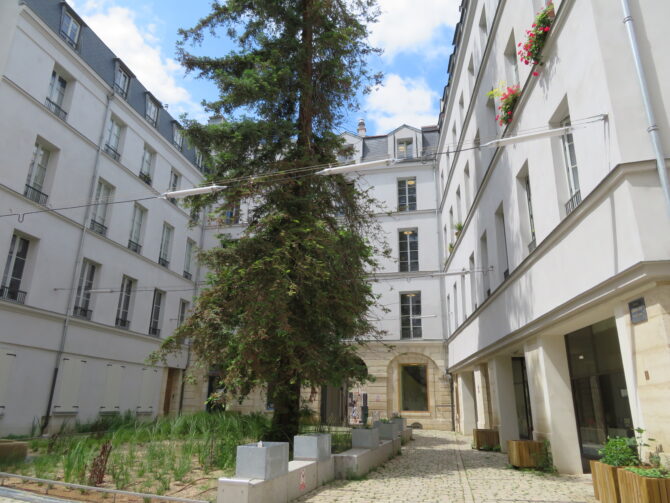

- SUBSCRIBE
- ALREADY SUBSCRIBED?
BECOME A BONJOUR PARIS MEMBER
Gain full access to our collection of over 5,000 articles and bring the City of Light into your life. Just 60 USD per year.
Find out why you should become a member here.
Sign in
Fill in your credentials below.
On the quieter Seine-side of the Marais, behind the Eglise Saint-Paul, lies the Village Saint-Paul, a peaceful enclave the size of a rectangular city block that encompasses a labyrinth of five cobblestoned courtyards. It is both remarkable and unremarkable. Remarkable for the diversity and individuality of the shops and galleries clustered along two sides of its perimeter as well as for the hidden world within; and unremarkable because, if you were not paying attention while passing along its boundaries, you might just miss it. And that would be a pity.
There’s more than one way to get to the Village Saint-Paul. The most straightforward is from the rue Saint-Antoine (either direction). Turn onto the rue Saint-Paul and carry on to where it intersects with the rue Charlemagne. It’s also quite pleasant to make your approach from the Seine — whether strolling the riverbank or along the Quai des Célestins — by starting at the opposite end of the rue Saint-Paul and walking one block to the corner of the rue de l’Ave Maria.
And then, there’s a third route, which I particularly recommend for history enthusiasts. Directly behind Métro Saint-Paul is the rue du Prévôt, an ancient cobblestoned alley, just over 9-feet wide for most of its length. Turn left onto the rue Charlemagne and at the end of the block you’ll spot the rue des Jardins de Saint-Paul, the western boundary of the Village Saint-Paul. First, however, you’ll come to the longest and best-preserved fragment of King Philip Augustus’ enceinte, the fortified wall that encircled the city of Paris at the end of the 12th century. It consists of a large chunk of the base of the turret plus the wall itself, which now forms one side of a modern athletic playing field constantly in use by the youth of the neighborhood.

The longest existing part of the Philippe Auguste Wall is located at the corner of rue Charlemagne and the rue des Jardins-Saint Paul. Photo credit: Sam Spade/ Wikimedia commons
Once arrived, there are 10 arched entryways leading from the surrounding streets into the inner courtyards. In one is a plaque stating that the Village Saint-Paul was built on the site of the former gardens of King Charles V (1338-1380) and, after a checkered history that included the French Revolution, in 1981 it took on a new identity as an artistic, commercial, and residential complex. Shortly before the pandemic, it was determined that a major refurbishment was in order. The new, spiffed-up version of the Village was introduced to Parisians in 2021.

The quartier Saint-Paul on the Vaugondy Map of 1760. Wikimedia Commons
To whet your appetite, here, in alphabetical order, is a sampling of shops, galleries, and more. A word of advice: Always check opening hours to avoid disappointment and note that some establishments are appointment only.
Au Debotté, 19 rue Saint-Paul
Antique shop with an opulent and tasteful collection of 18th-century furniture, tapestries, paintings, ceramics, and other decorative items of the period.
View this post on Instagram
Bien Fait, 23 rue Saint-Paul
A showroom of panoramic statement wall coverings, created by independent designers working in or with paints, pastels, photos, old engravings, et al. All papers are fabricated in France and sourced in accordance with the guidelines from the Forest Stewardship Council, an international organization whose mission is sustainable forest management.
View this post on Instagram
Brykalski, Cour Rabelais
Raffia rules in this indoor/outdoor boutique situated in one of the inner courtyards. It features a colorful and unusual collection of fashion and home accessories, some for every day, some more suited to the runway.
Côté Cailloux, 15 rue Saint-Paul
A little paradise for lovers of vintage costume jewelry. The collection includes pieces from the 18th and 19th centuries, the art nouveau, art deco, and the heyday of haute couture — think Chanel and Dior. Best of all, there is something for every budget.
E W, Objets Anciens, 21 rue Saint-Paul
“Objets anciens” is a pretty accurate description of this captivating hodge podge of a boutique. The stock trends nostalgic and whimsical and must run into the thousands of items. It’s hard not be tempted to pick up something that will surely elicit smiles and pleasant memories in the future. Maybe the best overall descriptive word for the shop is “fun.”
View this post on Instagram
Mon Artmour, 21 rue Saint-Paul
A newcomer to the Village, this boutique is a showcase for the individual hand-painted creations of its owner. These include champagne flutes, tea lights, vases, lamps, and more, any of which can be recreated according to a customer’s specifications.
Le Musée de la Magie, 11 rue Saint-Paul
Cached away underground in a 16th-century cave, the Magic Museum is particularly appealing to kids. Come for a crash course in illusions and magicians’ tricks of the trade, set the old-fashioned automated toys in motion, and take in a magic show. Also on offer are participatory workshops, bookable in advance. Something to bear in mind: when school is open, the museum will probably be closed.
View this post on Instagram
Samuel Gassmann, 1 rue Charlemagne
A boutique/workshop specializing in understated jewelry and accessories for men. The highlight of a visit is being able to observe the artisan (M. Gassmann) creating them in real time, by hand and machine(s).
View this post on Instagram
Sur le Fil de Paris, 2 rue Ave Maria
This antiquarian bookshop specializes in historical Paris and could be an excellent place to begin (or end) your exploration. The shop is well stocked with period postcards, photographs, and similar ephemera, which make perfect gifts and personal souvenirs.
View this post on Instagram
Lead photo credit : The Cours Rabelais in the Village Saint Paul in 2021. Photo credit: VVVCFFrance / Wikimedia commons
More in antiques, Marais district, Village Saint-Paul
